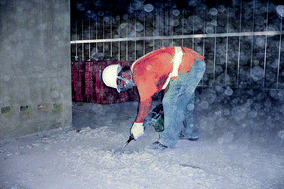Establishing aerosol exposure predictive models based on noise measurements—using concrete drilling as an example
Abstract
This study used a full scale mockup of a concrete drilling simulator to simulate drilling processes in an exposure chamber. Six drilling conditions were selected with rotating speeds and drill bit sizes varied from 265 to 587 rpm and 16 to 32 mm, respectively. For each drilling condition, the emitted noise power spectrums were measured and dust exposure concentrations of the fractions of the total (Ctot), inhalable (Cinh), thoracic (Ctho), and respirable (Cres) were estimated. We find that neither the resultant dust exposure levels nor the noise levels can be explained simply by the involved drilling mechanical energy. By dividing the emitted noise power spectrums into the high and low frequency noise (i.e., WH and WL), we find that 86.3%, 85.6%, 81.5%, and 77.6% variations of Ctot, Cinh, Ctho, and Cres could be explained by the combination of WH and WL, respectively. We also find that the emissions of coarse particles and WL were possibly contributed by two mechanisms of the impact wear and brittle fracture wear, whereas fine particles and WH could be contributed by the mechanism of abrasive wear. Although the predictive models obtained from this study could not be directly used in other dust emission sources, the developed methodology would be beneficial to industries in the future for aerosol exposure assessment, particularly when conducting conventional personal aerosol samplings is not possible in the field.


 Please wait while we load your content...
Please wait while we load your content...